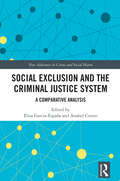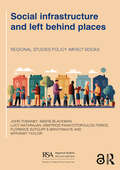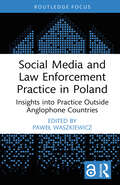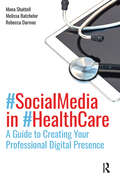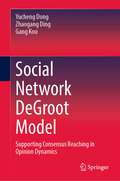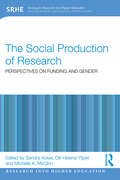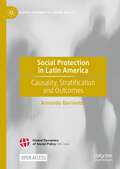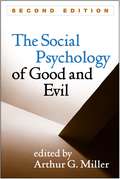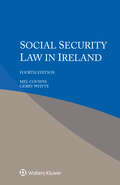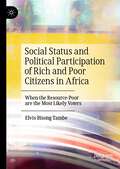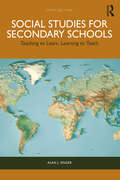- Table View
- List View
Social Exclusion and the Criminal Justice System: A Comparative Analysis (ISSN)
by Elisa García-España Anabel CerezoThis book presents the results of the latest in a long-running research project using the RIMES instrument, developed by scholars in Spain. Here, RIMES is used to measure the extent of social exclusion resulting from the penal system in comparative perspective. The volume shows the results of the application of the instrument in seven criminal justice systems: Germany, Italy, Spain, Poland, England and Wales, California, and New York.Divided into two parts, the first provides a general overview of the RIMES instrument, including a discussion of the theoretical model and the methodology. The second part focuses on the results of the application of RIMES in the seven jurisdictions. The comparative results are organised according to the nine dimensions included in the RIMES instrument: control of public spaces; legal safeguards; sentencing and sanctions systems; harshest penalties; prison rules; preventive intervention; legal and social status of offenders and ex-offenders; police and criminal records; and youth criminal justice. The last chapter summarizes the comparative results and ranks them in terms of the findings on social exclusion.The book will be of interest to academics, researchers and policy-makers working in the areas of Comparative Criminal Justice, Criminology, Criminal Law and Policy.
Social Formations in the Medieval World: From Roman Civilization till the Crisis of Feudalism
by Rakesh KumarThis book encapsulates a period of history of human progress by highlighting crucial social, economic, and cultural dynamics. It presents recent historiography and new analytical tools used to analyse multi-dimensional themes involved in social formation. This is a reader-friendly book with simple and lucid language and fulfils the pressing needs of students studying the paper ‘Social Formations and Cultural Patterns of Ancient and Medieval World’ at various universities across the world. The summary, keywords, and representative questions at the end of each chapter would assist in revision and better understanding of the issues dealt therein. A detailed chapter-end reference would enable and motivate the readers to engage in further studies for better understanding of the themes.This book will be of interest to students, researchers, and academics in the area of history—ancient and medieval world history in particular and anthropology. It will also be an interesting read for general readers interested in knowing about the ancient and medieval world.
Social Formations in the Medieval World: From Roman Civilization till the Crisis of Feudalism
by Rakesh KumarThis book encapsulates a period of history of human progress by highlighting crucial social, economic, and cultural dynamics. It presents recent historiography and new analytical tools used to analyse multi-dimensional themes involved in social formation. This is a reader-friendly book with simple and lucid language and fulfils the pressing needs of students studying the paper ‘Social Formations and Cultural Patterns of Ancient and Medieval World’ at various universities across the world. The summary, keywords, and representative questions at the end of each chapter would assist in revision and better understanding of the issues dealt therein. A detailed chapter-end reference would enable and motivate the readers to engage in further studies for better understanding of the themes.This book will be of interest to students, researchers, and academics in the area of history—ancient and medieval world history in particular and anthropology. It will also be an interesting read for general readers interested in knowing about the ancient and medieval world.
Social infrastructure and left behind places (Regional Studies Policy Impact Books)
by John Tomaney Maeve Blackman Lucy Natarajan Dimitrios Panayotopoulos-Tsiros Florence Sutcliffe-Braithwaite Myfanwy TaylorThis book explores the making, unmaking and remaking of social infrastructure in ‘left-behind places’. Such places, typically once flourishing industrial communities that have been excluded from recent economic growth, now attract academic and policy attention as sites of a political backlash against globalisation and liberal democracy. The book focuses on the role of social infrastructure as a key component of this story.Seeking to move beyond a narrowly economistic of reading ‘left behind places’, the book addresses the understudied affective dimensions of ‘left-behindness’. It develops an analytical framework that emphasises the importance of place attachments and the consequences of their disruption; considers ‘left behind places’ as ‘moral communities’ and the making of social infrastructure as an expression of this; views the unmaking of social infrastructure through the lens of ‘root shock’; and explains efforts at remaking it in terms of the articulation of ‘radical hope’.The analysis builds upon a case study of a former mining community in County Durham, North East England. Using mixed methods, it offers a ‘deep place study’ of a single village to understand more fully the making, unmaking and remaking of social infrastructure. It shows how a place once richly endowed with social infrastructure, saw this endowment wither and the effects this had on the community. However, it also records efforts of the local people to rebuild social infrastructure, typically drawing the lessons of the past. Although the story of one village, the methods, results and policy recommendation have much wider applicability.The book will be of interest to researchers, policy makers and others concerned with the fate of ‘left behind places’.The Open Access version of this book, available at http://www.taylorfrancis.com, has been made available under a Creative Commons Attribution-Non Commercial (CC-BY-NC) 4.0 license.
Social Justice Innovation in Africa (Routledge Studies in African Development)
by Laura Stark Maija Mustaniemi-Laakso Viljam EngströmAdopting a multidisciplinary approach, this book discusses the potential of social innovation in the pursuit of social justice in Africa. In the twenty-first century, social innovation and entrepreneurship have attracted renewed attention as a way of promoting social justice and addressing challenges of poverty and inequality.Drawing on perspectives from human rights, economics, business, development studies and anthropology, this book illustrates the entangled relationship between societal areas and activities, as well as different actors (individuals, communities, business actors, non-governmental organisations and public authorities) in social innovation. It identifies various models of social innovation, ranging from grassroots initiatives to public policymaking, and discusses their impact on socioeconomic welfare. It analyses a broad range of original research data and incorporates localised understandings of social innovation, highlighting both the empowering potential of social innovation and the possibility that it could sustain or create inequalities. As such, this book deepens an understanding of what makes social innovation ‘social’ and ‘just’.Arguing that social justice innovation can only be understood in context, this book will be of interest for researchers and policy makers across the fields of human rights, economics, business, development studies, anthropology and African studies.
Social Justice Innovation in Africa (Routledge Studies in African Development)
Adopting a multidisciplinary approach, this book discusses the potential of social innovation in the pursuit of social justice in Africa. In the twenty-first century, social innovation and entrepreneurship have attracted renewed attention as a way of promoting social justice and addressing challenges of poverty and inequality.Drawing on perspectives from human rights, economics, business, development studies and anthropology, this book illustrates the entangled relationship between societal areas and activities, as well as different actors (individuals, communities, business actors, non-governmental organisations and public authorities) in social innovation. It identifies various models of social innovation, ranging from grassroots initiatives to public policymaking, and discusses their impact on socioeconomic welfare. It analyses a broad range of original research data and incorporates localised understandings of social innovation, highlighting both the empowering potential of social innovation and the possibility that it could sustain or create inequalities. As such, this book deepens an understanding of what makes social innovation ‘social’ and ‘just’.Arguing that social justice innovation can only be understood in context, this book will be of interest for researchers and policy makers across the fields of human rights, economics, business, development studies, anthropology and African studies.
The Social Lives of Land (Cornell Series on Land: New Perspectives on Territory, Development, and Environment)
by Goldman Et Al.From the shaping of new homelands in the Cherokee Nation to the export of sand from Cambodia to shore up urban expansion in Singapore, The Social Lives of Land reveals the dynamics of contemporary social and political change. The editors of this volume bring together contributions from across multiple disciplines and geographic locations. The contributions showcase novel theoretical and empirical insights, analyzing how people are living on, with, and from their land. From Mozambique to India, Indonesia, Ecuador, and the colonial United States, the scholars in this collection uncover histories and retell stories with a focus on the lived experiences of rural and urban land dispossession and repossession.Contributors: Kati Álvarez, Clint Carroll, Flora Lu, Richard Mbunda, Gregg Mitman, Paul Nadasdy, Robert Nichols, Andrew Ofstehage, Laura Schoenberger, Kirsteen Shields, Emmanuel Sulle, Erik Swyngedouw, Gabriela Valdivia, Katherine Verdery, Callum Ward, Ciara Wirth, Emmanuel King Urey Yarkpawolo
Social Media and Law Enforcement Practice in Poland: Insights into Practice Outside Anglophone Countries (Routledge Studies in Crime, Culture and Media)
by Paweł WaszkiewiczThis book explores the role of social media in the daily practice of Polish criminal justice and how social media is, in turn, reshaping this practice. Based on empirical research, it confronts common beliefs about how police officers, prosecutors, and judges use social media in their work. Readers will find answers to the following questions: Which social media platforms are popular among law enforcement officers in Poland? How do the police use social media to investigate and prosecute crimes? What are the strategies for using social media to communicate with the community? What strategies are most successful?The findings in this book challenge some popular beliefs and theories about social media in criminal justice. As the first book to explore the use of social media in criminal justice outside of English-speaking countries, this collection of academic research will be of interest to academics focusing on criminology, criminal justice, and policing and will be useful to police leaders and officers, police social media administrators, prosecutors, and judges, who may be inspired by the research to implement new successful and more effective practices.The Open Access version of this book, available at www.taylorfrancis.com, has been made available under a Creative Commons Attribution-NonCommercial (CC-BY-NC) 4.0 International license. The costs of the Open Access publication were covered by the University of Warsaw under the Excellence Initiative Research University Action I.2.4 Supporting Open Access Publications.
Social Media and Law Enforcement Practice in Poland: Insights into Practice Outside Anglophone Countries (Routledge Studies in Crime, Culture and Media)
This book explores the role of social media in the daily practice of Polish criminal justice and how social media is, in turn, reshaping this practice. Based on empirical research, it confronts common beliefs about how police officers, prosecutors, and judges use social media in their work. Readers will find answers to the following questions: Which social media platforms are popular among law enforcement officers in Poland? How do the police use social media to investigate and prosecute crimes? What are the strategies for using social media to communicate with the community? What strategies are most successful?The findings in this book challenge some popular beliefs and theories about social media in criminal justice. As the first book to explore the use of social media in criminal justice outside of English-speaking countries, this collection of academic research will be of interest to academics focusing on criminology, criminal justice, and policing and will be useful to police leaders and officers, police social media administrators, prosecutors, and judges, who may be inspired by the research to implement new successful and more effective practices.The Open Access version of this book, available at www.taylorfrancis.com, has been made available under a Creative Commons Attribution-NonCommercial (CC-BY-NC) 4.0 International license. The costs of the Open Access publication were covered by the University of Warsaw under the Excellence Initiative Research University Action I.2.4 Supporting Open Access Publications.
Social Media in Health Care: A Guide to Creating Your Professional Digital Presence
by Mona Shattell Melissa Batchelor Rebecca DarmocA practical, essential guide to social media for health care professionals, Social Media in Health Care equips readers with the skills to build their online brand, share their professional knowledge with a wider audience, and become a trusted source of information and thought leader in their field.Authors Mona Shattell, Melissa Batchelor, and Rebecca Darmoc explain the principles behind building a respected digital presence and developing meaningful online connections, while providing practical tips for navigating the five major social media platforms: Twitter, LinkedIn, Facebook, Instagram, and YouTube. Everyone from health care students to the most seasoned professionals will benefit from the 3C’s Framework outlined in the book: Consume, Contribute, and Create.Social Media in Health Care can be read cover to cover or used as quick reference guide. Topics include: Exercises for novice, intermediate, and advanced users Best practices for consuming, sharing, and creating content Tips for readers to build their social media presence and professional brand Recommendations for using digital platforms to expand professional networks Patient privacy concerns and how to avoid ethical pitfalls Social media can start conversations and serve as an open line of communication between peers, the public, and patients. Social Media in Health Care guides members of the medical community in how to use social media to help educate the public and specific patient communities about health care and health policy, make connections with industry leaders and peers, and enhance their professional reputation.
Social Media in Health Care: A Guide to Creating Your Professional Digital Presence
A practical, essential guide to social media for health care professionals, Social Media in Health Care equips readers with the skills to build their online brand, share their professional knowledge with a wider audience, and become a trusted source of information and thought leader in their field.Authors Mona Shattell, Melissa Batchelor, and Rebecca Darmoc explain the principles behind building a respected digital presence and developing meaningful online connections, while providing practical tips for navigating the five major social media platforms: Twitter, LinkedIn, Facebook, Instagram, and YouTube. Everyone from health care students to the most seasoned professionals will benefit from the 3C’s Framework outlined in the book: Consume, Contribute, and Create.Social Media in Health Care can be read cover to cover or used as quick reference guide. Topics include: Exercises for novice, intermediate, and advanced users Best practices for consuming, sharing, and creating content Tips for readers to build their social media presence and professional brand Recommendations for using digital platforms to expand professional networks Patient privacy concerns and how to avoid ethical pitfalls Social media can start conversations and serve as an open line of communication between peers, the public, and patients. Social Media in Health Care guides members of the medical community in how to use social media to help educate the public and specific patient communities about health care and health policy, make connections with industry leaders and peers, and enhance their professional reputation.
Social-Media-Strategien für B2B-Unternehmen: Von der Konzeption bis zur Umsetzung in den verschiedenen Netzwerken (essentials)
by Constanze WolffStark praxisorientiert und mit konkreten Beispielen zeigt dieses Buch auf, wie B2B-Unternehmen von sozialen Netzwerken profitieren können. Die Lesenden erfahren das Wichtigste über die Social-Media-Landschaft in Deutschland und lernen, wie sie eine individuelle Social-Media-Strategie aufsetzen und diese in den verschiedenen Netzwerken umsetzen. Denn die Suche nach neuen Lieferant*innen, Mitarbeitenden und Kund*innen spielt sich auf Social Media ab – und auch im Service, bei der Verbreitung von Fachinformationen und der Generierung von Website-Traffic geht kein Weg mehr an LinkedIn, Instagram, X und Co. vorbei.
Social Mobility: And Its Enemies (Pelican Books)
by Stephen Machin Lee Elliot MajorWhat are the effects of decreasing social mobility?How does education help - and hinder - us in improving our life chances?Why are so many of us stuck on the same social rung as our parents? Apart from the USA, Britain has the lowest social mobility in the Western world. The lack of movement in who gets where in society - particularly when people are stuck at the bottom and the top - costs the nation dear, both in terms of the unfulfilled talents of those left behind and an increasingly detached elite, disinterested in improvements that benefit the rest of society.This book analyses cutting-edge research into how social mobility has changed in Britain over the years, the shifting role of schools and universities in creating a fairer future, and the key to what makes some countries and regions so much richer in opportunities, bringing a clearer understanding of what works and how we can better shape our future.
The Social Nature of Antibiotic Overprescription in China: Medical Conversations, Doctor–Patient Relationships, and Decision-Making (Routledge Studies in Language, Health and Culture)
by Nan Christine WangOffering a rarely seen glimpse into the realities of one of the biggest global public health crises in modern time, Wang’s book focuses on doctor–patient interactions in China to demonstrate the potential effects of health communication, doctor–patient relationship, and a matrix of social factors on overprescription of antibiotics.Based on a community-based survey, the book describes empirical findings regarding the high prevalence of non-prescribed antibiotics use for common colds among children in China. It covers the potential effects of overprescription on caregivers' attitudes and how physicians make prescribing decisions in medical consultations. Drawing from evidence in medical interaction data, readers are introduced to further empirical findings regarding the communicative behaviors that patient caregivers use to pressure for antibiotic prescriptions in real medical consultations. Following this, Wang reports findings regarding the communicative behaviors that physicians use to make treatment recommendations and caregivers use to launch treatment negotiations, leading to a discussion of the effect of the doctor–patient relationship on antibiotic overprescription. The book culminates in practice recommendations and provides teaching scenarios in which physicians successfully engage the caregivers into conversations to shape their expectations for antibiotic prescriptions in medical consultations.An important resource for scholars and students in health communication, linguistics, medical humanities, and medical sociology. Practitioners who are interested in understanding and improving clinical practices as well as policymakers aiming to combat antibiotic resistance will also find this book useful.
The Social Nature of Antibiotic Overprescription in China: Medical Conversations, Doctor–Patient Relationships, and Decision-Making (Routledge Studies in Language, Health and Culture)
by Nan Christine WangOffering a rarely seen glimpse into the realities of one of the biggest global public health crises in modern time, Wang’s book focuses on doctor–patient interactions in China to demonstrate the potential effects of health communication, doctor–patient relationship, and a matrix of social factors on overprescription of antibiotics.Based on a community-based survey, the book describes empirical findings regarding the high prevalence of non-prescribed antibiotics use for common colds among children in China. It covers the potential effects of overprescription on caregivers' attitudes and how physicians make prescribing decisions in medical consultations. Drawing from evidence in medical interaction data, readers are introduced to further empirical findings regarding the communicative behaviors that patient caregivers use to pressure for antibiotic prescriptions in real medical consultations. Following this, Wang reports findings regarding the communicative behaviors that physicians use to make treatment recommendations and caregivers use to launch treatment negotiations, leading to a discussion of the effect of the doctor–patient relationship on antibiotic overprescription. The book culminates in practice recommendations and provides teaching scenarios in which physicians successfully engage the caregivers into conversations to shape their expectations for antibiotic prescriptions in medical consultations.An important resource for scholars and students in health communication, linguistics, medical humanities, and medical sociology. Practitioners who are interested in understanding and improving clinical practices as well as policymakers aiming to combat antibiotic resistance will also find this book useful.
Social Network DeGroot Model: Supporting Consensus Reaching in Opinion Dynamics
by Gang Kou Yucheng Dong Zhaogang DingThis book investigates the DeGroot model in social network contexts, and proposes the social network DeGroot (SNDG) model. Specifically, this book focuses on two core research problems in the SNDG model: (i) Social network structures to reach a stable state (consensus, polarization, or fragmentation); and (ii) the convergence rate to reach a stable state. Furthermore, the authors generalize the SNDG model in an uncertain context, showing the effects of interval opinions on the SNDG model. In this book, the authors also discuss the applications of the SNDG model to support group decision making, including consensus reaching through adding minimum interactions, trust relationships manipulations, and risk control issues in the social network. Apart from theoretical analysis, detailed experimental simulations with real and random data will be applied to validate our research.This book is the first to connect opinion dynamics, social network and group decision making. The resultsreported can help us understand the evolution of public opinions in social network contexts and provide new tools to support consensus reaching in group decision making.
The Social Production of Research: Perspectives on Funding and Gender (ISSN)
by Sandra Acker Oili-Helena Ylijoki Michelle K. McGinnThe Social Production of Research offers critical perspectives on the interrelations between research funding and gender, in a climate where universities expect accountability and publishing productivity to be maintained at peak levels.Drawing upon a range of qualitative methods, contributors investigate experiences with research funding; the nature of institutional, funding body and country contexts; and the impact of social change and disruptions on research ecosystems and academic careers in Canada, Finland, Sweden and the UK. Nuanced accounts call attention to the social, emotional and political conditions within which research is produced, while identifying the ways academics enact, shape, negotiate and resist those conditions in their everyday practice.Featuring thought-provoking and critical insights for an international readership, this volume is an essential resource for researchers, academics, administrators, managers, funders, politicians and others who are concerned about the future of research funding and the importance of gender equity.
The Social Production of Research: Perspectives on Funding and Gender (ISSN)
by Sandra Acker Oili-Helena Ylijoki Michelle K. McGinnThe Social Production of Research offers critical perspectives on the interrelations between research funding and gender, in a climate where universities expect accountability and publishing productivity to be maintained at peak levels.Drawing upon a range of qualitative methods, contributors investigate experiences with research funding; the nature of institutional, funding body and country contexts; and the impact of social change and disruptions on research ecosystems and academic careers in Canada, Finland, Sweden and the UK. Nuanced accounts call attention to the social, emotional and political conditions within which research is produced, while identifying the ways academics enact, shape, negotiate and resist those conditions in their everyday practice.Featuring thought-provoking and critical insights for an international readership, this volume is an essential resource for researchers, academics, administrators, managers, funders, politicians and others who are concerned about the future of research funding and the importance of gender equity.
Social Protection in Latin America: Causality, Stratification and Outcomes (Global Dynamics of Social Policy)
by Armando BarrientosThis book offers a comprehensive analysis of social protection in Latin America, its origins, institutions, and outcomes. The chapters are organised in three groups. The earlier chapters discuss in turn appropriate methods, an analytical framework, and core institutions. The book advocates a causal inference approach to the study of the institutions that have dominated social protection in the region: occupational insurance, individual retirement savings, and social assistance. The middle chapters study social protection’s main stratification effects, focussing on stratification effects on employment, protection, and worker incorporation. The later chapters then assess social protection outcomes and identify country groupings including their evolution over time. The book, and its approach and findings, contributes to the advancement of a theory of social protection amongst late industrialisers.This is an open access book.
The Social Psychology Of Good And Evil
by Arthur G. MillerThis timely, accessible reference and text addresses some of the most fundamental questions about human behavior, such as what causes racism and prejudice and why good people do bad things. Leading authorities present state-of-the-science theoretical and empirical work. Essential themes include the complex interaction of individual, societal, and situational factors underpinning good or evil behavior; the role of moral emotions, unconscious bias, and the self-concept; issues of responsibility and motivation; and how technology and globalization have enabled newer forms of threat and harm.
The Social Science of the COVID-19 Pandemic: A Call to Action for Researchers
by Monica K. MillerAlthough the world has experienced many epidemics, the novel coronavirus (COVID-19) is exactly that--novel. The impacts on society's way of life, education, family, and economy are drastic. As a result, people seek explanations that have answers rooted in social science. The Social Science of the COVID-19 Pandemic: A Call to Action for Researchers draws on theories derived from the social sciences to address the multitude of questions raised by the pandemic and to inspire a future generation of researchers. This book focuses specifically on the social science of a pandemic. While medical, health, and other sciences are critical to understanding a pandemic, so, too, is understanding the role of society and person. Together, psychology and society shape every aspect of life, and the COVID-19 pandemic is no exception to this pattern. Parts of society--and science--will be forever affected. Edited by Monica K. Miller, The Social Science of the COVID-19 Pandemic is a collection of academic essays written by a group of international authors. The book begins by overviewing the timeline of the pandemic and how it affected life. It then discusses behaviors and experiences during the pandemic, followed by sections on outcomes after the pandemic and best practices for conducting future studies during or about the pandemic. This book is an expansive, go-to text designed to help promote recovery from the pandemic, to minimize the negative effects of similar events in the future, and to inform social science research going forward.
The Social Science of the COVID-19 Pandemic: A Call to Action for Researchers
Although the world has experienced many epidemics, the novel coronavirus (COVID-19) is exactly that--novel. The impacts on society's way of life, education, family, and economy are drastic. As a result, people seek explanations that have answers rooted in social science. The Social Science of the COVID-19 Pandemic: A Call to Action for Researchers draws on theories derived from the social sciences to address the multitude of questions raised by the pandemic and to inspire a future generation of researchers. This book focuses specifically on the social science of a pandemic. While medical, health, and other sciences are critical to understanding a pandemic, so, too, is understanding the role of society and person. Together, psychology and society shape every aspect of life, and the COVID-19 pandemic is no exception to this pattern. Parts of society--and science--will be forever affected. Edited by Monica K. Miller, The Social Science of the COVID-19 Pandemic is a collection of academic essays written by a group of international authors. The book begins by overviewing the timeline of the pandemic and how it affected life. It then discusses behaviors and experiences during the pandemic, followed by sections on outcomes after the pandemic and best practices for conducting future studies during or about the pandemic. This book is an expansive, go-to text designed to help promote recovery from the pandemic, to minimize the negative effects of similar events in the future, and to inform social science research going forward.
Social Security Law in Ireland
by Mel Cousins Gerry WhyteDerived from the renowned multi-volume International Encyclopaedia of Laws, this book describes the social security regime in Ireland. It conveys a clear working knowledge of the legal mechanics affecting health care, employment injuries and occupational diseases, incapacity to work, pensions, survivors’ benefits, unemployment benefits and services, and family benefits. The analysis covers the field of application, conditions for entitlement, calculation of benefits, financing, the institutional framework, and relevant law enforcement and controls. Allowances for retirees, employees, public sector workers, the self-employed, and the handicapped are all clearly explained, along with full details of claims, adjudication procedures, and appeals. Succinct yet eminently practical, the book will be a valuable resource for lawyers handling social security matters in Ireland. It will be of practical utility to those both in public service and private practice called on to develop and to apply social security law and policy, and of special interest as a contribution to the comparative study of social security systems.
Social Status and Political Participation of Rich and Poor Citizens in Africa: When the Resource-Poor are the Most Likely Voters
by Elvis Bisong TambeThis book seeks to explore a fundamental obscurity in electoral behavior literature: while socioeconomic status is typically robustly and positively associated with a higher propensity for voting worldwide, the relationship in Africa is either negative or non-existent. Building upon the author’s previous works relating to political participation, behavior and electoral processes, this work focuses specifically on 35 sub-Saharan African political system case studies and analyzes why resource-poor Africans tend to display greater electoral participation than their more comparatively affluent counterparts. Drawing from a methodological–theoretical framework utilizing Afrobarometer data and group mobilization theories such as the civic voluntarism model, electoral clientelism, democratic quality, preference theory and institutional perspectives, this book makes an original contribution to analyzing African regions less well-examined in existing comparative participatory political science literatures.
Social Studies for Secondary Schools: Teaching to Learn, Learning to Teach
by Alan J. SingerNow in its fifth edition, this popular text for secondary social studies methods courses integrates discussions of educational goals and the nature of history and social studies with ideas for organizing social studies curricula, units, lessons, projects, and activities. Advocating an inquiry and activity-based view of social studies teaching that respects the points of view of students and teachers, it offers systematic support and open, honest advice for new teachers.Based in practice and experience, lesson ideas and materials in the book and online are designed to help new teachers address Common Core learning standards, to work in inclusive settings, and to promote literacy and the use of technology in social studies classrooms. Chapters include highlighted Learning Activities, Teaching Activities, and Classroom Activities designed to provoke discussion and illustrate different approaches to teaching social studies and conclude with recommendations for further reading. Features of the fifth edition include: Activities called "Think it over," "Add your voice to the discussion," "Try it yourself," and "It’s your classroom” at the end of each chapter New topics such as the 1619 Project controversy, Stop WOKE campaigns, academic freedom, and legal restraints on 7–12 teachers New content on teaching literacy, including writing, reading, media, computer, and oral literacies Approaches to teaching advanced placement, international baccalaureate, and dual enrollment classes Multi-disciplinary and project-based teaching that combines history and social studies with the social sciences and other academic disciplines Links to the NCSS 3-C framework Information on becoming a professional leader through involvement in organizations like the NCSS and teacher unions Designed for undergraduate and graduate pre-service social studies methods courses, this text is also useful for in-service training programs, as a reference for new social studies teachers, and as a resource for experienced social studies educators who are engaged in rethinking their teaching practice.This text is supported by online materials, including discussion questions, lesson ideas, and links to lesson materials and activity sheets. You can find the resources here: https://alansinger.net/social-studies-for-secondary-schools/
